Introduction
Tanker trucks are essential in various industries, primarily for transporting liquids, including water, fuel, chemicals, and food products. Understanding the holding capacity of these trucks is crucial for logistics managers, transporters, and consumers alike. This article will explore the different capacities of tanker trucks, factors affecting these capacities, and practical applications in real-world scenarios. By the end of this guide, you will have a detailed comprehension of how many gallons a tanker truck can hold and how this impacts various sectors.
Types of Tanker Trucks
Before diving into the calculations of how many gallons a tanker truck can hold, it is vital to understand the types of tanker trucks available. Each type has specific features and capacities suited for particular liquids.
1. Liquid Tanker Trucks
Liquid tanker trucks are designed to transport a variety of liquids. Their holding capacity can range significantly based on the design and purpose.
2. Fuel Tanker Trucks
Fuel tanker trucks are specifically designed for transporting gasoline, diesel, and other fuels. They feature multiple compartments to transport different types of fuel simultaneously.
3. Chemical Tanker Trucks
These tanker trucks are specially built to transport hazardous and non-hazardous chemicals. They usually have coatings and features to handle corrosive materials safely.
4. Food Tanker Trucks
Food tanker trucks are used for transporting liquid food products, such as milk, fruit juices, and oils. They follow strict sanitary regulations.
Typical Capacities of Tanker Trucks
The capacity of a tanker truck can vary widely based on its design and usage. Here’s a breakdown of the most common types:
| Tanker Type | Typical Capacity (Gallons) |
|---|---|
| Liquid Tanker Truck | 5,000 – 10,000 |
| Fuel Tanker Truck | 8,000 – 11,000 |
| Chemical Tanker Truck | 5,000 – 12,000 |
| Food Tanker Truck | 5,000 – 7,000 |
Factors Affecting Tanker Truck Capacity
Several factors influence the carrying capacity of a tanker truck. Understanding these elements is essential for effective planning and operations.
1. Design and Structure
The shape and design of the tanker play significant roles in determining how many gallons it can hold. More cylindrical designs tend to maximize efficiency and volume.
2. Type of Liquid
The type of liquid being transported also affects capacity. Different liquids have distinct densities, which can change the calculations for weight limits and volume.
3. Regulations and Safety Standards
Government regulations often impose limits on how much a truck can legally carry, even if the physical capacity is higher. These standards are crucial for safe transportation.
4. Truck Specifications
Truck specifications such as the axle weight limit and trailer length can limit how much liquid can be carried, regardless of tanker capacity.
Examples of Tanker Truck Capacities
Let’s explore some specific examples to illustrate how many gallons different types of tanker trucks can hold.
1. Standard Fuel Tanker Example
A standard fuel tanker truck generally holds around 9,000 gallons. This allows for efficient refueling services at gas stations. Here’s how the calculations break down:
- Fuel weight: Approximately 6-7 lbs per gallon
- Maximum weight for trucks: 80,000 lbs (including truck weight + fuel)
2. Chemical Tanker Example
For a chemical tanker designed to carry non-hazardous materials, the capacity can reach up to 12,000 gallons. The exact volume depends on the material’s density and the truck’s construction.
3. Food Tanker Example
Food tanker trucks can typically hold between 5,000 and 7,000 gallons of liquid food products. For example, a milk tanker often has a capacity of around 6,000 gallons, ensuring efficient transport for dairy farms.
Practical Tips for Businesses Using Tanker Trucks
When utilizing tanker trucks in business operations, there are several practical tips to consider for maximization of efficiency and compliance.
1. Plan Routes Wisely
Effective route planning ensures you maximize load capabilities while minimizing travel time and costs.
2. Understand Regulations
Stay updated on local, state, and federal regulations regarding weight limits and safety standards to avoid penalties and ensure safe delivery of materials.
3. Regular Maintenance
Keep tanker trucks in optimal condition with routine inspections and maintenance to avoid on-road breakdowns and ensure safety.
4. Invest in Training
Provide regular training for drivers on handling specific types of liquids, understanding weight distribution, and managing emergencies effectively.
Future Trends in Tanker Transportation
As technology advances, the future of tanker transportation looks promising, with innovations that could enhance capacity and safety.
1. Smart Technologies
Integration of GPS and IoT devices into tanker trucks is becoming increasingly common. These technologies can aid in tracking liquid levels and optimizing routes based on real-time data.
2. Eco-Friendly Options
With growing environmental concerns, the industry is moving towards eco-friendly alternatives, including LNG (liquefied natural gas) and biofuels for tanker operations.
3. Enhanced Safety Features
Innovations in safety technology, such as automated braking systems and better roll stability, will continue to evolve in tanker trucks, making them safer on the road.
Frequently Asked Questions (FAQ)
1. How much does a typical tanker truck weigh when fully loaded?
A fully loaded tanker truck can weigh up to 80,000 lbs, including the weight of the truck itself and the liquid it carries.
2. What are the typical dimensions of a tanker truck?
Most tanker trucks are about 40 to 60 feet long and 8.5 feet wide, but the height can vary based on the design.
3. Can tanker trucks carry hazardous materials?
Yes, specialized chemical tanker trucks are designed to safely transport hazardous materials, and they follow strict safety protocols.
4. How do tanker truck drivers ensure safety while transporting liquids?
Drivers undergo extensive training, including handling emergencies, understanding weight distributions, and following regulatory guidelines.
5. Are there weight restrictions for tanker trucks in certain areas?
Yes, local and state regulations often impose weight limits on roads, which can affect how much liquid can be carried.
6. What is the average lifespan of a tanker truck?
The average lifespan of a well-maintained tanker truck is typically between 10 to 15 years, depending on usage and maintenance practices.





